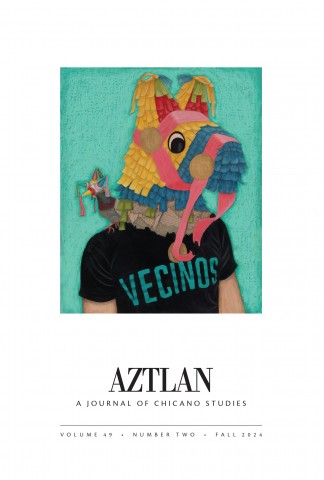Aztlán: A Journal of Chicano Studies
ABOUT
Aztlán presents original research that is relevant to or informed by the Chicano experience. An interdisciplinary, double-blind peer-reviewed journal, Aztlán focuses on scholarly essays in the humanities, social sciences, and arts, supplemented by thematic pieces in the dossier section, an artist's communiqué, a review section, and a commentary by the editor, Charlene Villaseñor Black. Aztlán seeks ways to bring Chicano studies into critical dialogue with Latino, ethnic, American, and global studies.
Aztlán has been the leading journal in the field of Chicanx studies since 1970. Aztlán is issued twice a year.
"Aztlán … signals the vibrancy of Chicano Studies."
— The Chronicle of Higher Education
"The preeminent scholarly journal in Chicano Studies."
— Magazines for Libraries
"This esteemed journal of record is essential for virtually all academic libraries."
— Library Journal
Beginning January 1, 2024, Aztlán will be published by University of California Press (UC Press) in collaboration with CSRC Press. The journal will continue to be offered in print and digital formats.
For more information and to subscribe, visit online.ucpress.edu/aztlan.
The Commentary in the Fall 2024 issue is available for download free of charge on the UC Press site.
Follow the journal's Facebook page.
LATEST ISSUE
Volume 49 Number 2
Fall 2024
The Editor's Commentary, by Charlene Villaseñor Black and photographer Hernán Robleto, presents an overview of the the student activism that took place at UCLA in April, May, and June 2024 to protest the Palestinian genocide in Gaza.
The opening essays explore how Chicanx communities navigate and influence social change. Anthony R. Jerry compares the structures and strategies of two San Diego–based nonprofit organizations, and Lorena V. Márquez addresses the shift in focus from Chicanx rights to a broader emphasis on pan-Latinx immigrant and human rights in the 1980s. The final essays explore intersections of violence and exploitation within Chicanx communities via media texts. Salvador Zárate considers the film A Better Life (2011) in his examination of collaboration between the carceral state archive and ethnographic practices, and Alicia Muñoz looks at the concepts of slow violence and gore capitalism in the novel Bang! (2017).
The Dossier section, curated by Richard T. Rodríguez and David Lloyd, celebrates the life and work of beloved poet, writer, scholar, and teacher Alfred Arteaga. An essay by Arteaga and a 2010 interview join personal remembrances, poetic tributes, and scholarly analyses of Arteaga's work. New translations into English of three of Arteaga's poems complete the section. In addition to the curators, the contributors are Frederick Luis Aldama, José Anguiano, Harry Gamboa Jr., Ramón García, Kirsten Silva Gruesz, Melissa Mora Hidalgo, Ryuta Imafuku, Marcelle Maese, José Navarro, and Laura E. Pérez.
This issue features the work of Albuquerque-based artist Vicente Telles.
Cover image: Vicente Telles, Mi Amigo the Pigeon, 2022. Watercolor, oil pastel, and traditional gesso on Masonite panel, 18 x 22 inches. Private collection. Photography by Carr Imaging.
To subscribe, click here.
To purchase and download digital issues, visit online.ucpress.edu/aztlan
EDITORIAL BOARD 2024–2026
Ella Maria Diaz, San José State University

